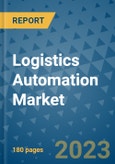The Fourth Industrial Revolution has ushered in a new era of technological advancements, with AI replacing humans in various spheres and smart cars operating without human drivers. In such times, the calls for automation of logistics have become natural. Logistics automation involves the adoption of technology and smart systems to manage and optimize inventory, transportation of goods, warehouse management, and order fulfillment. This automation eliminates errors, reduces costs, and exponentially increases overall efficiency. As e-commerce expands and personalized offerings take center stage, the logistics automation market has seen significant growth.
Widening E-Commerce Propels Logistics Automation Market
The technology revolution has impacted every aspect of commerce and markets, with e-marketplaces becoming ubiquitous. The drive to improve customer satisfaction and offer same-day deliveries for online stores has led to warehouse collaborations, cross-vendor management, and last-mile delivery firms. These developments have placed increased burdens on logistics networks, demanding sophisticated and complex solutions to address related issues. To meet the need for swift and accurate order fulfillment, companies are investing in automated systems such as robotic picking and packing, conveyor systems, and sorting machines. Hence, the rampant rise of e-commerce is a major driver behind the growth of the logistics automation market.Technological Zeitgeist Calls for Logistics Automation
Manual handling of logistics processes can be time-consuming and error-prone. Modern logistics frameworks enable real-time tracking, monitoring shipments, and space optimization, facilitating faster inventory replenishments and other advantages. The integration of robotics, automated packaging, and last-mile delivery automation into a single framework has made these advancements possible. Logistics automation has become essential for a company's sustainability as industries seek to optimize supply chains, cut costs, and enhance customer satisfaction. By converging various technologies and harnessing the power of automation, companies can automate manual tasks, reduce errors, and maximize resource utilization.North America Leads Logistics Automation Market with Well-Established Infrastructure
North America stands out as one of the top regions in the logistics automation market. The presence of cutting-edge logistical infrastructure, well-established e-commerce firms, and a tech-savvy customer base have fueled the development of automation in this region. Major logistics and e-commerce companies in North America are aggressively investing in logistics automation to improve supply chain operations, meet consumer demands, and gain a competitive edge. Europe, like North America, is experiencing rapid growth in the logistics automation sector. With extensive transit networks and sophisticated e-commerce markets, Germany, the United Kingdom, and the Netherlands are at the forefront of logistics automation adoption.Key Market Players
Major players in the logistics automation market include Beumer Group, Daifuku Co. Ltd., Dematic, Honeywell Intelligrated, Knapp AG, Murata Machinery Ltd., Swisslog Holding AG, TGW Logistics Group, Toshiba Infrastructure Systems & Solutions Corporation, and Vitronic Dr. ING. Stein.Table of Contents
1. Executive Summary
2. Market Overview
3. Global Logistics Automation Market Outlook, 2018 - 2030
4. North America Logistics Automation Market Outlook, 2018 - 2030
5. Europe Logistics Automation Market Outlook, 2018 - 2030
6. Asia Pacific Logistics Automation Market Outlook, 2018 - 2030
7. Latin America Logistics Automation Market Outlook, 2018 - 2030
8. Middle East & Africa Logistics Automation Market Outlook, 2018 - 2030
9. Competitive Landscape
10. Appendix
Companies Mentioned
- Daifuku Co., Ltd.
- TGW Logistics Group
- BEUMER Group
- ABB Ltd.
- Honeywell International Inc.
- Kion Group AG
- Kardex
- SSI Schaefer Group
- GreyOrange
- Jungheinrich AG
- Knapp AG
- Mecalux S.A
- Oracle Corporation
Methodology

LOADING...








